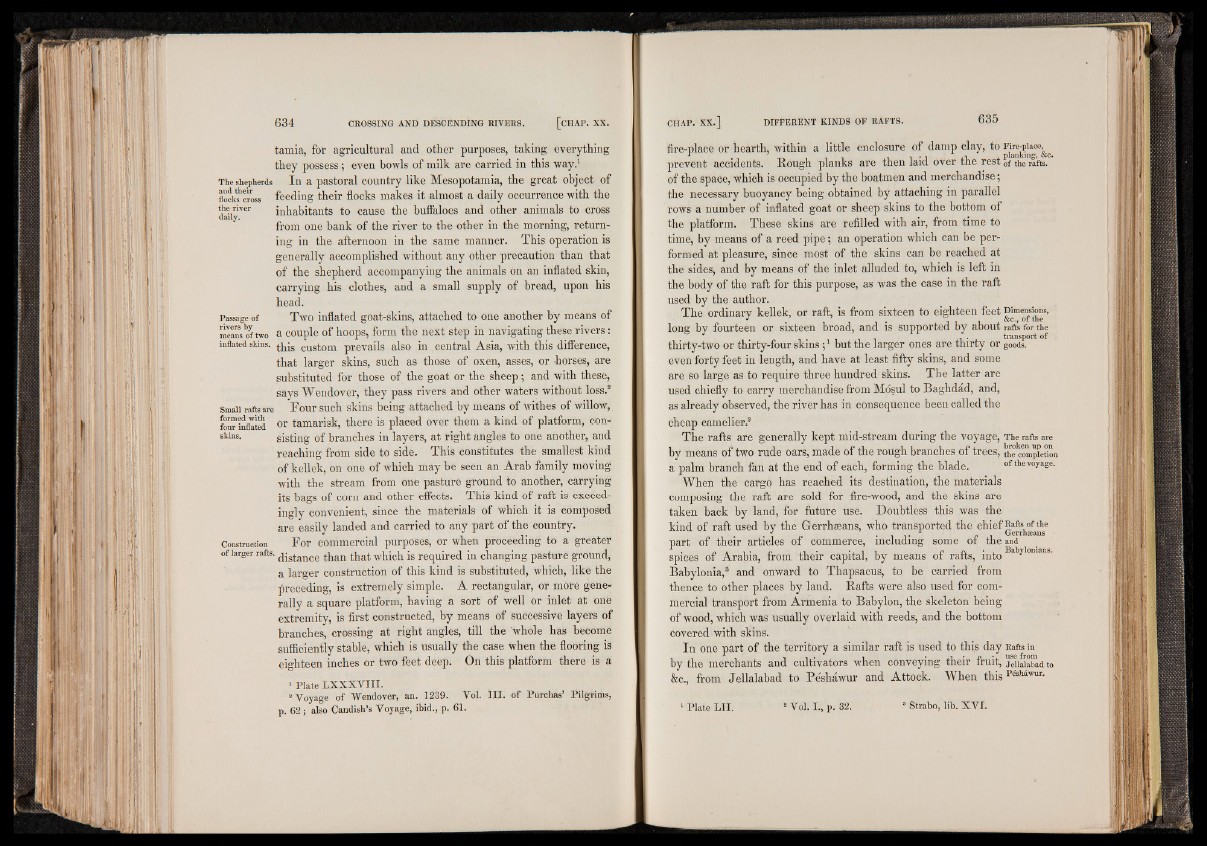
tamia, for agricultural and other purposes, taking everything
they possess; even bowls of milk are carried in this way.1
The shepherds In a pastoral country like Mesopotamia, the great object of
floek cross feeding their flocks makes it almost a daily occurrence with the
the river inhabitants to cause the buffaloes and other animals to cross daily.
from one bank of the river to the other in the morning, returning
in the afternoon in the same manner. This operation is
generally accomplished without any other precaution than that
of the shepherd accompanying the animals on an inflated skin,
carrying his clothes, and a small supply of bread, upon his
head.
Passage of Two inflated goat-skins, attached to one another by means of
means'of two a couple of hoops, form the next step in navigating these rivers:
inflated skins. ^ ¡s cust0m prevails also in central Asia, with this difference,
that larger skins, such as those of oxen, asses, or -horses, are
substituted for those of the goat or the sheep; and with these,
says Wendover, they pass rivers and other waters without loss.8
Small rafts are Four such skins being attached by means of withes of willow,
fonr inflated or tamarisk, there is placed over them a kind of platform, con-
skins. sisting of branches in layers, at right angles to one another, and
reaching from side to side. This constitutes the smallest kind
of kellek, on one of which may be seen an Arab family moving
with the stream from one pasture ground to another, carrying
its bags of corn and other effects. This kind of raft is exceedingly
convenient, since the materials of which it is composed
are easily landed and carried to any part of the country.
Construction For commercial purposes, or when proceeding to a greater
O f larger rafts. ¿ j g t a n c e than that which is required in changing pasture ground,
a larger construction of this kind is substituted, which, like the
preceding, is extremely simple. A rectangular, or more generally
a square platform, having a sort of well or inlet at one
extremity, is first constructed, by means of successive layers of
branches, crossing at right angles, till the whole has become
sufficiently stable, which is usually the case when the flooring is
eighteen inches or two feet deep. On this platform there is a
1 Plate L X X X V I I I .
2 Voyage of Wendover, an. 1239. Vol. I I I . of Purchas’ Pilgrims,
p. 62 ; also Candish’s Voyage, ibid., p. 61.
fire-place or hearth, within a little enclosure of damp clay, to Fire-place,
a i i planking, &c. prevent accidents. Rough planks are then laid over the rest 0f the rafts,
of the space, which is occupied by the boatmen and merchandise;
the necessary buoyancy being obtained by attaching in parallel
rows a number of inflated goat or sheep skins to the bottom of
the platform. These skins are refilled with air, from time to
time, by means of a reed pipe; an operation which can be performed
at pleasure, since most of the skins can be reached at
the sides, and by means of the inlet alluded to, which is left in
the body of the raft for this purpose, as was the case in the raft
used by the author.
The ordinary kellek, or raft, is from sixteen to eighteen feet Dimensions,
. , . j i &c.f of the long by fourteen or sixteen broad, and is supported by about rafts for the
. . transport of I thirty-two or thirty-four skins;1 but the larger ones are thirty or goods,
even forty feet in length, and have at least fifty skins, and some
are so large as to require three hundred skins. The latter are
used chiefly to carry merchandise from Mosul to Baghdad, and,
as already observed, the river has in consequence been called the
cheap camelier.8
The rafts are generally kept mid-stream during the voyage, The rafts are
by means of two rude oars, made of the rough branches of trees, the completion
a palm branch fan at the end of each, forming the blade. of the voyage.
When the cargo has reached its destination, the materials
composing the raft are sold for fire-wood, and the skins are
taken back by land, for future use. Doubtless this was the
kind of raft used by the Gerrhsans, who transported the chief Kafte of the
J . . . Gerrhaeans -
part of their articles of commerce, including some of the and
spices of Arabia, from their capital, by means of rafts, into Baby’omans-
Babylonia,8 and onward to Thapsacus, to be carried from
thence to other places by land. Bafts were also used for commercial
transport from Armenia to Babylon, the skeleton being
of wood, which was usually overlaid with reeds, and the bottom
covered with skins.
In one part of the territory a similar raft is used to this day Rafts in
by the merchants and cultivators when conveying their fruit, jenaiabad to
&c., from Jellalabad to Peshawur and Attock. When thisPesh4wur-
1 Plate L II. s Vol. I., p. 32. 8 Strabo, lib. X V I.